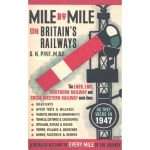Browsing in a bookshop in Hay on Wye back in 2009, there was a magical moment. There was a Bradshaw’s Directory for November 1939, a paperback edition published at 2 shillings and sixpence. Bradshaw’s had every timetable for every railway line in the country. There were reprints of Bradshaw’s from 1910 and 1922, but they had no special feel about them. The 1939 edition was well thumbed; amongst its pages were slips of fading paper upon which had been written the times for various journeys. Holding the book, it was hard to imagine in whose hands that book may have lain.
It was not just the fact that it was original and from a far bygone age, it was the date of the timetable that inspired trains of thoughts: November 1939. As Europe went into a tailspin into a hellish darkness and Britain was left alone by May 1940, there was not much reassurance in the world, not much that continued undamaged by the shadow of the evil of National Socialism.
Standing in the shop, questions went through the mind: what had the owner of that copy of Bradshaw’s thought as he turned through its pages in the summer of 1940? As everything else crumbled away, did the train service remain one of few constant things? Did the ability to catch the 7.53 to work each morning remain one of the few bright and hopeful things amongst an avalanche of bad news?
Who bought their own copy of Bradshaw’s in those days? What business was transacted through the journeys planned in those neat pencil figures?
A whole range of characters ran through the mind in the speculation on what the owner may have been like, but the most likely seemed a middle aged man, the younger men having gone away as part of the war effort. A man, perhaps with a moustache and dark spectacles, sat at a table under the dim light of a gas lamp, perusing the tiny figures in the columns of the timetables. What world did he imagine as he sat there, relying on dirty steam locomotives to give his world some order?
Published at 2/6, the bookshop was asking for £40 the Bradshaw’s – it seemed too much and I put it back on the shelf. On reflection, £40 was only half the price of a ticket for a rugby international at Lansdowne Road, and the book would have given hours of reading and imagining.
Going into Keeble’s Bookshop in Langport on Monday, I asked if there might be a Bradshaw’s in stock. There wasn’t, but what I did find was a copy of S.N. Pike’s ‘Mile by Mile on Britain’s Railways’, an account of every mile on the mainline railways of 1947, reprinted at £12.99. It is excellent. All that is now required to make the magic complete is a copy of Bradshaw’s to know the times of the trains on those railways.
